The Royals – as every Londoner at least used to know – are not members of the Saxe-Coburg and Gotha family (or Windsor as they prefer to be known since 1917) but docks in London’s East End, the Royal Victoria, Albert and King George V, stretching between them from Canning Town to Cyprus – not the Meditteranean island but North Woolwich. Like the rest of London’s inner docks they closed long ago, back in the 1970s or so.
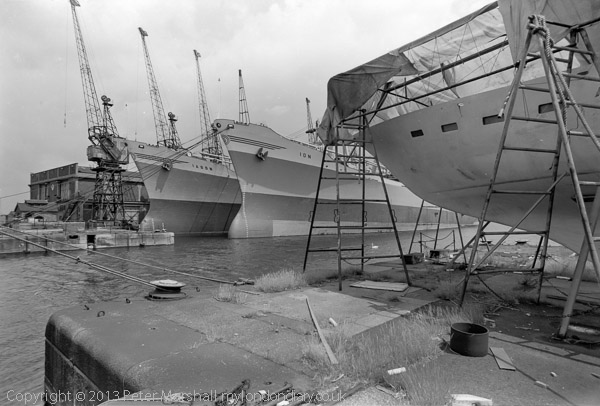
King George V Dock, 1984
I never saw them at work, but started to photograph the area two years after the final closure of the in 1981 (they had been running down for some time), but before the area around them was in part developed. It was a huge area – together they were said to be the largest enclosed docks in the world, with around 250 acres of water and a total area of over a thousand acres, almost 5 square kilometres.
It’s now the home to one of the UK’s cheapest and most expensive tourist attractions – cheap for the cost of the cable car ride from the terminal at the west end of the Victoria Dock and across the river to North Greenwich. I had to be in docklands to give a talk yesterday lunchtime, and had planned to take a rather leisurely route home across it, but the weather defeated both me and it.
The ‘Arab dangleway’ isn’t a serious form of transport, but a modern ‘folly’ (and like that horrid red metal tangled mass on the Olympic site and the new Routemaster example o what you get when you elect a clown as mayor.) According Darryl Chamberlain, the auuthor of the local Greenwich 853 blog (named for the former telephone area code and definitive reading if you want to know what’s happening in the area) it has a total of 16 regular commuters; for most the Jubilee line to Canning Town and the easy change to the DLR are faster, more reliable and cheaper. As a visitor attraction, the cost for those with an Oyster or Travelcard is certaiinly cheap compared to most, but this is the most expensive cable car system ever built, and so far has cost taxpayers over £24 million (with around £30m from private finance) with another £8 million from the European Regional Development Fund.
On looking at the advance weather forecast I’d realised that my plans were to be dashed, with snow and high winds forecast – snow would obscure the views and the cable car doesn’t run when it’s windy, and I walked around Canary Wharf in a blizzard taking a few pictures on the coldest day in London for years finding it at times difficult to keep upright and clutching on to hand rails for support. The pictures weren’t much but if I hadn’t taken them I would have worried later about the opportunity I’d missed! But I had similar problems to our railways – it was obviously the wrong type of snow. At least I wasn’t bothered by security who were probably busier trying to keep warm than worrying about photographers, and the snow probably made the CCTV hard to follow.
But my talk was about my photographs of Docklands, to a small audience who knew more about the area than I did, but I had the advantage of having been there before them and could show a little of how things were in the late 1970s and early 1980s. I was showing only black and white work I’d made from when I started photographing London around 1974 until around ten years later. Much of that time my main photographic project was in Hull, but I’d also done a fair amount along both of London’s major rivers, the Thames and the Lee, including the former dock areas. And one of the more organised projects was on the Royals and the surrounding area.
I’d walked around the area, getting there by the train service that then ran from Stratford to North Woolwich, stopping at Canning Town and Silvertown (it would have been easier though probably not faster for me the following year when the service in May 1985 ran all the way from Richmond to North Woolwich) or taking a train to Woolwich Arsenal and then walking under the river or taking the free ferry to North Woolwich. Transport in the whole docklands area has certainly improved since then, with the Jubilee Line extended to Stratford and the DLR. Even the bus services are generally better.
Although shipping into the Royals had stopped, the two eastern docks – Albert and George V – were still mainly fenced off with gates closed and security men at the main gatehouse, with a few small businesses still operating on the site. So although I could take some pictures around them – and in an area close to the dock entrance where some of the fences had gone, I had to write to the PLA and ask for access to take photographs, getting permission to work on the site for two days. (To the west the Royal Victoria was privately owned and I was unable to get inside.)
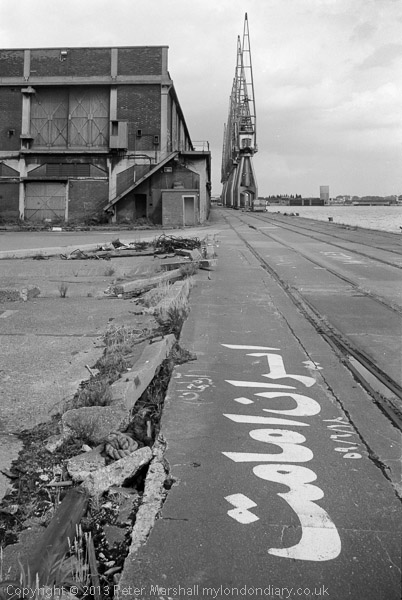
King George V Dock, 1984
It was a strange feeling, wandering around the largely empty dockside, the only person in a vast area full of semi-derelict buildings. There were still a few signs of life, with washing drying on one small vessel and a car parked outside a small office at one edge of the site – and another small business stil operating in one corner of the site. And one solitary rower training on the mile and a quarter of open water in the Royal Albert – other than him I saw only one other person during two days there. As I wandered around, there were many signs of those who had worked there, particularly the Lascar seamen who, according to FamilySearch “made up perhaps 20 percent of the British maritime labor force in the early 20th century, with their total exceeding 26 percent by 1938.”
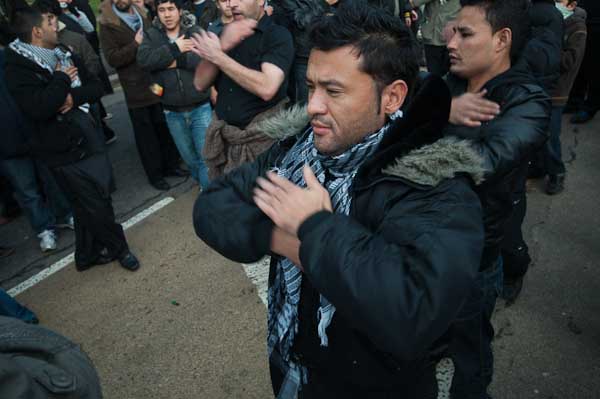
Ashura procession, London, 2009
From various largely Muslim areas of India, Pakistan and other points east, they crewed many of the engine rooms, galleys and other areas of British ships, and when in docks such as the Royals continued their religious celebrations. On what our dockers referred to as ‘Hobson-Jobson days’, the held religious processions inside the docks. The name, best known as the title of the Anglo-Indian lexicon by Yule and Burnell produced in the 1870s, came from the British soldier’s version of the cry ‘Ya Hasan! Ya Husayn!’ (O Hassan! O Husain!) in the annual Shi’ite Ashura processions mourning the killing of Imam Husain in the Karbala massacre of 680 AD.
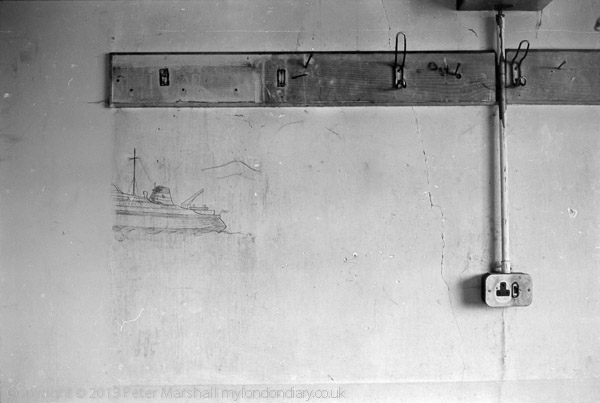
King George V Dock, 1984
The planning enquiry into the building of London City airport had already begun, and demolition on the site for it started not long after I took my pictures, with the airport opening around 3 years later. For noise reasons it was allowed on the basis it would be usede by a very limited service of special planes that could take off and land at a steep angle, but a dozen years later the airport operators got permission to extend the runway to allow a wider range of planes to use it, and more recently part of the airport has been extended over the water of King George dock to enable even more flights and greater noise and pollution for the many residents in the surrouding areas of London. Like Heathrow, it’s an airport that was allowed in the wrong place and has grown by a process of deliberate misleading of the public and authorities. Like Heathrow further expansion is impractical. Unlike Heathrow it has a reputation for being a good place to travel from.
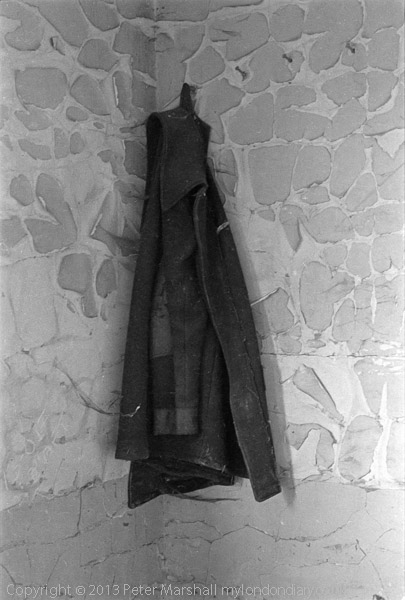
King George V Dock, 1984
Some of the smaller offices and other buildings had been left as if those working there had just gone out to lunch, with part drunk cups of tea, the odd coat hanging on a peg, and paperwork and rubber stamps on the desks. There were notices and posters still on the wall, along with the odd drawing and fading pictures from pornographic magazines.
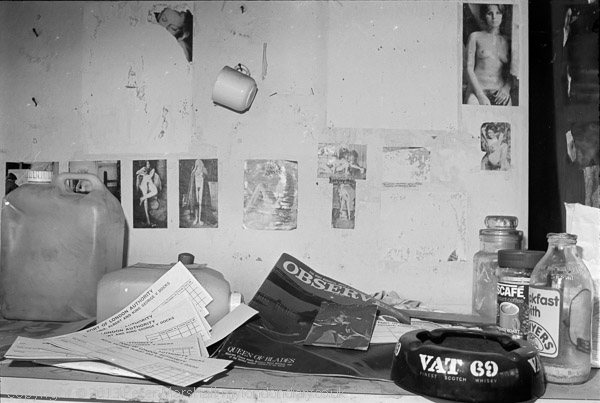
King George V Dock, 1984
This is a project I’ve shown little work from over the years, partly because I had great problems printing some of the images, but more because I moved on to other things. I hope shortly to bring out a body of the work in another book, and possibly also on the web.
________________________________________________________
My London Diary : Buildings of London : River Lea/Lee Valley : London’s Industrial Heritage
All photographs on this and my other sites, unless otherwise stated are by Peter Marshall and are available for reproduction or can be bought as prints.
To order prints or reproduce images
________________________________________________________
One thought on “The Royals – 1984”